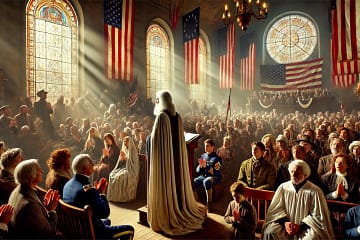“A Connecticut Yankee in King Arthur’s Court” is a novel by Mark Twain, published in 1889. This work combines adventure, satire, and humor, set against the backdrop of medieval England. The protagonist, Hank Morgan, a 19th-century Yankee engineer from Connecticut, inexplicably finds himself transported to the court of King Arthur. Through his modern knowledge and ingenuity, Hank attempts to transform the archaic society while contending with its rigid norms and superstitions. Twain uses this premise to critique contemporary society and institutions, blending historical fiction with speculative elements.
Comprehensive Plot Summary
Hank Morgan, a practical and resourceful engineer from Connecticut, finds himself inexplicably transported back to the 6th century after a blow to the head during a confrontation. Awakening under an oak tree, he encounters a knight clad in full armor, who demands his surrender. Confused and thinking he might be part of a circus or an asylum, Hank reluctantly complies. As they travel, Hank realizes he is not dreaming but has indeed been transported to medieval England, specifically to the kingdom of Camelot.
Upon reaching Camelot, Hank witnesses the stark contrasts between his modern world and this ancient time. The primitive state of the people, their lack of hygiene, and the rudimentary state of technology baffle him. He is soon imprisoned and brought before King Arthur and his knights. Faced with execution, Hank uses his knowledge of a forthcoming solar eclipse to save his life, proclaiming himself a powerful magician capable of blotting out the sun. His prediction comes true, earning him respect and a position of power in the court.
Adopting the title of “The Boss,” Hank begins implementing modern ideas and technologies, aiming to reform the medieval society. He establishes schools, factories, and even a patent office, slowly introducing the concepts of democracy and industrialization. Despite his efforts, Hank faces constant challenges from the entrenched beliefs and superstitions of the people, as well as opposition from Merlin, the court magician, who views Hank as a threat.
Hank’s relationship with the people of Camelot is complex. He befriends some, like Clarence, a young and loyal page, but also makes enemies. His modern ideas and methods often clash with the medieval mindset. During his travels, Hank encounters various adventures, including freeing captives from knights and attempting to rescue King Arthur, who has been imprisoned. These exploits reveal the harsh realities of medieval life and the brutality of the feudal system.
Despite Hank’s successes, the rigidity of the medieval social structure proves resilient. King Arthur, though initially supportive, becomes increasingly wary of Hank’s influence. The church, represented by powerful figures like Bishop Bagdemagus, also stands against Hank’s reforms, fearing the loss of its authority.
As Hank continues his quest to modernize Camelot, he falls in love with Alisande (Sandy), a maiden he initially rescues. Their relationship adds a personal dimension to his journey, intertwining his mission with his growing affection for her. However, the more Hank changes society, the more resistance he faces.
The climax of the tale occurs when Hank and King Arthur, disguised as commoners, travel the countryside to understand the lives of their subjects. They are captured and sold into slavery, experiencing firsthand the oppression they sought to eliminate. After a daring escape, they return to Camelot, only to find the kingdom in turmoil. A full-scale war breaks out, pitting Hank’s modernized forces against the traditional knights.
In a final, desperate battle, Hank’s advanced technology initially gives him an edge. However, the overwhelming numbers and fanaticism of the knights lead to a tragic conclusion. Hank is grievously wounded and eventually succumbs to his injuries, reflecting on the futility of his efforts to bring about change.
Hank’s journey from a 19th-century engineer to a medieval magician reveals his ingenuity and determination. Yet, it also exposes the limits of his ability to change a society deeply rooted in tradition and superstition. His efforts to educate and industrialize Camelot are met with both admiration and fear, and his modern inventions clash with the ancient world’s resistance to change.
During his time in Camelot, Hank faces numerous challenges and adventures. He outsmarts knights, defeats giants, and even combats Merlin’s magical influence. Through these trials, he earns respect and loyalty, particularly from Clarence, whose unwavering support becomes a cornerstone of Hank’s efforts. However, Hank’s modern sensibilities often put him at odds with the entrenched social norms and powerful institutions of the time.
One of Hank’s most significant achievements is the establishment of a secret society dedicated to knowledge and progress. He trains a group of young, bright individuals in the ways of modern science and technology, hoping they will continue his work. This society operates in secrecy, away from the prying eyes of the church and the nobility, ensuring the survival of Hank’s ideas.
As Hank’s influence grows, so does the tension between him and Merlin. The ancient magician, threatened by Hank’s prowess, continuously schemes to undermine him. Their rivalry symbolizes the broader conflict between progress and tradition, a central theme in Hank’s journey.
The story takes a darker turn when Hank and Arthur, while traveling incognito, are captured and enslaved. This experience is a stark contrast to their previous adventures and highlights the harsh realities of medieval life. It is during this time that Hank’s belief in his mission is tested, and he gains a deeper understanding of the people’s suffering.
Upon their escape and return to Camelot, they find the kingdom in chaos. The war between Hank’s modernized army and the traditional knights reaches its peak. Despite Hank’s strategic genius and technological superiority, the sheer number of his adversaries and their unyielding determination lead to a devastating battle.
In his final moments, Hank reflects on his journey, his love for Sandy, and the friends he made. His dying thoughts are filled with both pride and sorrow. He realizes that while he may not have succeeded in transforming Camelot entirely, he planted the seeds of change. The young members of his secret society represent hope for the future, carrying forward his vision of a more enlightened and progressive world.
As Hank succumbs to his injuries, the narrative closes on a poignant note. His legacy, though not fully realized in his lifetime, hints at the possibility of future transformation. The tale of Hank Morgan, the Connecticut Yankee, serves as a powerful commentary on the clash between modernity and tradition, the potential of innovation, and the enduring struggle for progress in the face of overwhelming odds.
Main Characters
- Hank Morgan: The protagonist, a resourceful and pragmatic engineer from Connecticut, who finds himself in King Arthur’s court and uses his modern knowledge to reform medieval society.
- King Arthur: The legendary ruler of Camelot, initially supportive of Hank but eventually wary of his influence.
- Merlin: The court magician and Hank’s primary antagonist, representing the old ways and superstitions of the medieval world.
- Clarence: A young page who becomes Hank’s loyal friend and ally, aiding him in his various endeavors.
- Alisande (Sandy): A maiden Hank rescues and falls in love with, adding a romantic element to his journey.
Themes and Motifs
- Modernity vs. Tradition: The clash between Hank’s contemporary knowledge and the entrenched medieval customs highlights the tension between progress and conservatism.
- Power and Authority: Twain critiques the abuse of power by both the monarchy and the church, showcasing the arbitrary nature of authority in medieval society.
- Technology and Industrialization: Hank’s efforts to introduce modern technology serve as a commentary on the transformative power of innovation and its potential to disrupt established norms.
- Satire and Social Critique: Through humor and irony, Twain critiques the romanticized view of the medieval past and draws parallels to the issues of his own time, including class disparity and institutional corruption.
Writing Style and Tone
Mark Twain’s writing style in “A Connecticut Yankee in King Arthur’s Court” is characterized by his trademark wit, humor, and satire. He blends a conversational tone with vivid descriptions, making the medieval setting both authentic and accessible. Twain’s use of first-person narrative allows Hank’s modern perspective to shine through, adding a layer of irony as he navigates the archaic world of Camelot. The tone oscillates between light-hearted humor and serious social critique, effectively highlighting the absurdities of both medieval and contemporary societies. Twain’s linguistic choices, including the use of colloquial language and dialects, enhance the realism and relatability of the characters and their experiences.


